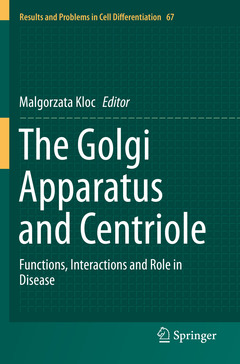The Golgi Apparatus and Centriole, 1st ed. 2019 Functions, Interactions and Role in Disease Results and Problems in Cell Differentiation Series, Vol. 67
Coordonnateur : Kloc Malgorzata

This volume takes a closer look how the cell organelles Golgi apparatus (also known as the Golgi complex or Golgi body), and centriole are structurally and functionally intertwined.
Initially, it was believed that the role of Golgi complex is limited to the packaging and preparation for secretion of various cellular proteins, while the centriole participates in cell division and cilia formation. However, since their discovery nearly 200 years ago, it became clear that these two organelles are interacting, and that their functions are much more complex and far reaching than previously thought. Recent findings indicate that the Golgi?Centriole relationship may be important for directional protein transport, cell polarization and cell cycle progression. Current studies indicate that Golgi and centriole also participate in development and act as cellular and immunological sensors, and that their abnormalities lead to cell and developmental abnormalities, Alzheimer, cancer, variouslipid disorders and neurological and immunological diseases in humans.
This volume combines the latest information on the structure, molecular composition, and roles of Golgi and centriole in various cellular functions and diseases. The better understanding of the Golgi?centriole interactions may lead to the development of novel therapies for the treatment of various diseases, including cancer.
Dr. Malgorzata Kloc completed her PhD in Poland on insect oogenesis, and worked as a tenured Assistant Professor at University of Warsaw. In 1981, she immigrated to Canada and received fellowship from Alberta Heritage Foundation at Calgary University, Alberta, where she studied the heat shock proteins in Xenopus oocytes, and later at Saint Mary’s university in Halifax, Nova Scotia, and after that at Dalhousie University in Halifax where she received Terry Fox Foundation fellowship in molecular biology. In 1987, she moved to Houston, USA and worked at MD Anderson Cancer Center on Xenopus germ cell specification and development, and localized mRNA and cytoskeleton. She left MD Anderson in the rank of Associate Professor in 2007 and moved to Houston Methodist Hospital and Research Institute where she currently has a rank of Weill Cornell Professor of cell and molecular biology. At Methodist she studies the role of macrophages, cytoskeleton and RhoA pathway in development of chronic rejection of transplanted organs.
Date de parution : 09-2020
Ouvrage de 529 p.
15.5x23.5 cm
Date de parution : 09-2019
Ouvrage de 529 p.
15.5x23.5 cm



